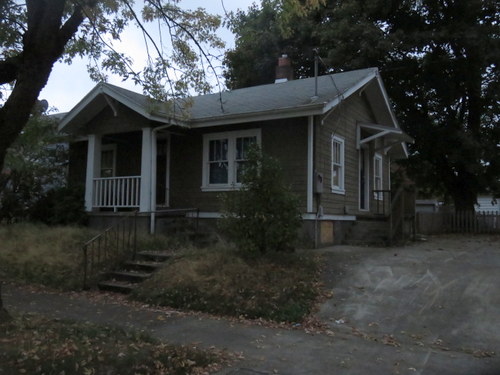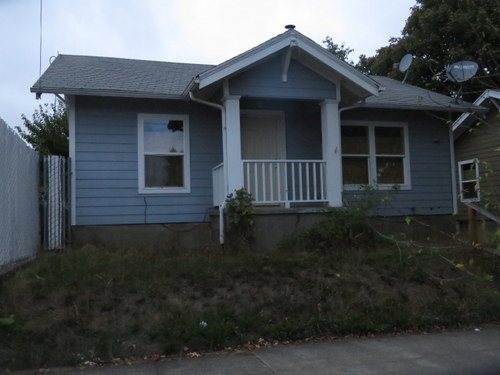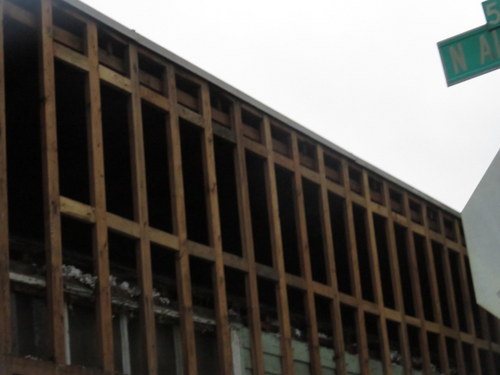These pictures came out darker than I thought. Apparently I took them at the time of day when my eyes register more light than my camera.
These three houses were mostly boarded up from the inside, so I didn’t notice that they had been vacated. They are on Denver Ave., just off of Rosa Parks Way. They are the type of house I love: small house, bigger lot. North Portland had a ton of these houses when I moved here in 2007. There are fewer now. And soon there will be three fewer.
Portland Maps shows an interesting situation for these houses. Two of them are on the same lot (6541 N. Denver) and the lot seems to extend into the third house, though it has it’s own address (6525 N. Denver). The middle house is not shown as having an address, both on Portland Maps and on Google Maps. However, the information on Portland Maps shows square footage for all three houses in the 6541 N. Denver record and there’s no information on the third house in the 6525 N. Denver record, So I’m assuming all three houses are included on one lot.
The lot was last sold in 1977 for $58,500. According to an inflation calculator, that’s about $231,000 of today’s dollars. I’m unclear if that $58k price reflects that it has three houses on it. In June, this lot sold for [and here I must interject via brackets that the number I’m about to type makes me literally nauseous] $1.6 million.
Wait! It seems the $1.6m is for all three houses on the block, plus the former recycling center on the corner. Nausea has slightly abated. Only slightly. My favorite site Next Portland had this to say on 10/27/17 :
Proposed development of a split zoning site, CG and R5. four story apartment building (20 units or more) on the GC portion of the site and 2 new single family homes on the R5 portion of the site. All existing structures on site to be demoed.
By dividing $1.6m four ways, that roughly pencils out to $400,000 per lot.
Four hundred thousand dollars for just the land. That’s before the demo.
And that, friends, is why we have a homelessness problem in Portland.
Fun fact, I first noticed these houses had been boarded up when I saw one of our neighborhood homeless residents sleeping on the porch of the red house.
Onto the houses. This guy is 600 square feet, with a full basement. It’s the corner lot and has a nice big backyard.

This house is 720 square feet with a full basement. The assessment also includes 500 square feet of concrete which you see in the picture. It serves as the driveway for both houses. This is my favorite house of the three, though I think it has the smaller yard.

This house is 720 square feet with a full basement. It is right next to the former recycling center.

The records don’t say, but I’m guessing houses 2 and 3 were built by the same builder. They look very much the same. There’s a good chance house the first house was built then too. They have a lot of the same lines.
The record on Portland Maps only lists 1922 as a build date and it doesn’t specify if that year applies to all three houses. Either way, I will miss their presence.
Here’s a side view of where the recycling center used to be. Portland Maps says this garage (it probably was one before it was the recycling center) was built in 1950. I can’t tell if this property was owned by the same person who owned the houses, but my guess is yes. If so, that person made a tidy profit on this sale.

The recycling center (Far West Fibers) closed soon after China stopped taking plastic from the USA, citing too much contamination. It was too bad, as this was a handy place for me to drop off the plastic that couldn’t be recycled curbside.
Bonus picture! The property at 1936 NE Alberta. It’s a bit of office/shop space in the middle of a residential neighborhood. These are always a fun find for me. They are almost never shops or offices anymore, as our shopping patterns have changed enough that they are not viable as neighborhood shops.
Today, though, I was even more excited to find this detail.

Exposed: the previous shell of the building. It looks like sometime–I’m guessing mid-twentieth century–this building was revitalized to make it more modern. The sides were built out to make the structure more box-like and the brick was added.

If it weren’t a little too dark, you could see the former slanted roof which has been covered by the more modern flat roof.

Despite its office-looking appearance, Portland Maps lists this as a single family residential building. It was bought in 1994 for $135,000 (about $236k today) and was sold in 2017 for $695,000. The owners live on site, so I’m not sure what their plan is. Live in it? Demo and rebuild? It’s a big enough lot they could. There’s nothing on Next Portland’s development map, so we shall have to see.
Either way, I’m glad I got a chance to peek at what was there before.

The three houses are such cuties. Too bad they have to go!
I so rarely wander to your blog, for which I am sorry. But here I am now! These wee houses (plus the recycling center) are going to be 66 one-bedroom apartments with zero green space and also a duplex. There is a lot of emotion in the ‘hood regarding this project. Big efforts are being made to help the developer replace some of those units with commercial space. Apparently one-bedroom apartments are where all the money is, though. I miss my recycling center and I will miss those wee houses for walking by.
It’s always nice to have you, whenever you wander by.
Thanks for the neighborhood-level insight. I would prefer to see a variety of apartment sizes. It seems like every building in Portland is full of one-bedroom apartments. From my own observations, I’m starting to question the mixed-use concept. I can think of a lot of apartment buildings on Interstate that have commercial space at ground floor and that commercial space has never been occupied. Aside from restaurants and haircuts, we’ve really shifted to an economy that doesn’t support smaller retail spaces. People do their shopping via big box stores and Amazon.
While I like the idea of many small shops within walking distance and appreciate that many buildings in Portland are built that way, I wonder if it’s worse to have continually empty commercial space?